The Forbidden City (故宫 (Gùgōng)), located at the centre of Beijing, was the main palace of Imperial China for five centuries, until the early 20th century. It today houses the Palace Museum, one of China's largest national museums, with an extensive collection based on the former imperial collection. This is truly the spot to appreciate the might and grandeur of the Imperial Chinese court during the height of its power in the Ming and Qing dynasties.
Administratively, the Forbidden City precinct is part of Dongcheng district, but it is historically distinct and has many sights of its own, so we cover it in a separate article.
The Forbidden City is a very big place with lots to see: a typical visit covering the main palace buildings and the main museum displays will usually take a full day. If you are pressed for time, consider focusing on only the main halls and just a couple of the museum sections.
Understand
The name "Forbidden City" comes from the Chinese Zǐjìn Chéng (紫禁城), referring to the rule that no one from outside the court was allowed in without the emperor's permission. Those few caught trespassing could be, and often were, executed on the spot (unless they were one of the invading armies that breached the walls, in which case the emperor was often the one in danger of execution). Since it was the common term at the time Western nations began making contact with China, it is still used in many Western languages. In China today the complex is simply referred to as the Gùgōng (故宫) or the Old Palace.
Geography
.jpg/440px-View_from_Jingshan_Park_(6230253295).jpg) The Forbidden City is rectangular in shape, surrounded by a moat. It has four gates, the main one being the south gate, Meridian Gate, facing Tiananmen Square. It is situated on Beijing's north-south muncipal axis, between the Dongcheng and Xicheng districts that comprise the city centre.
The Forbidden City is rectangular in shape, surrounded by a moat. It has four gates, the main one being the south gate, Meridian Gate, facing Tiananmen Square. It is situated on Beijing's north-south muncipal axis, between the Dongcheng and Xicheng districts that comprise the city centre.
It occupies 72 hectares (180 acres) of land, though it may seem much larger due to the vast courtyards and the length of time most visitors spend there. On that land are 980 buildings, containing almost 10,000 rooms (although that estimate may be on the high end). According to UNESCO, the Forbidden City is the largest collection of ancient wooden buildings in the world.
The palace grounds proper are divided into the Outer Court to the south and the Inner Court on the north. The former has the larger courtyards and buildings and was primarily used for ceremonies and other public events; the latter was living quarters, with smaller buildings and the gardens. Today it is also home to the food court, as well.
History
While the Forbidden City is often seen in the Western imagination of China as the palace of all that country's emperors going back thousands of years, in reality it has only stood since the 15th century CE.
The Mongol emperor Kublai Khan set the stage for the creation of the Forbidden City when he decided in 1272 that he'd rather have his capital at what came to be known as Khanbaliq (or, in the West, Cambaluc) than the stately pleasure-dome he'd already decreed at Xanadu to the north, in traditionally Mongol territory. His palace was around Lake Taiye, now the Shichahai chain of lakes north of the present Forbidden City, in what he named Dadu, or "great capital". Within a century the Hongwu Emperor had driven the Mongols out and started the Ming dynasty. He ordered the Mongol palaces demolished, renamed the city Beiping ("northern peace") and moved his capital to what is now Nanjing.
That move lasted merely a few decades, an intermission in the millenia of Chinese history. In 1402 Zhu Di, the prince of Beiping, usurped the throne. Proclaiming himself the Yongle ("perpetual happiness") emperor, he moved the capital back to Beiping and began the construction of a grand imperial palace south of the lakes.
A million ordinary laborers, and 100,000 craftsmen, worked for 15 years to complete the palace. Entire whole logs of the phoebe tree were used to make the pillars in many important rooms. The "golden bricks" that still floor some of the major rooms were baked for six months in the ovens to acquire a distinctive metallic ring. Soil excavated to create the moat was piled up just north of the palace, creating Jingshan Park.
So pleased was Zhu Di that he had effectively moved in before 1420, the year the palace was complete. He did not get to enjoy it for too long as the three main halls, including the throne room, burned down less than a year later. It took 23 years before they were rebuilt.
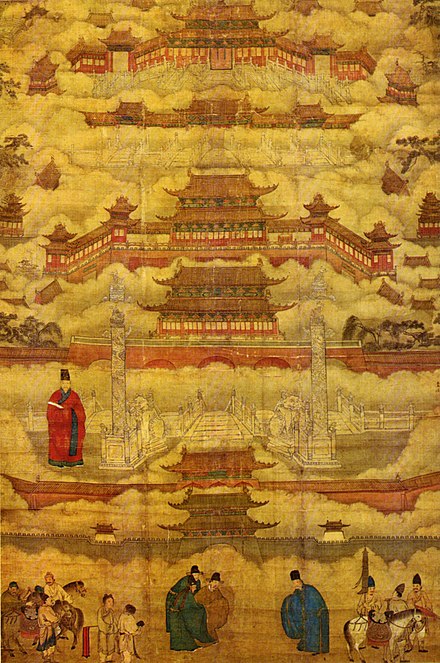 All the remaining Ming emperors would sit at the palace, and expand and maintain it. The last one, Chongzhen, fled the palace before invading Manchurians in 1644 and hanged himself atop Jingshan Hill. The Manchurians installed themselves as the Qing dynasty, changing some of the names of the buildings slightly, moving from an emphasis on peace and harmony to supremacy and extremity.
All the remaining Ming emperors would sit at the palace, and expand and maintain it. The last one, Chongzhen, fled the palace before invading Manchurians in 1644 and hanged himself atop Jingshan Hill. The Manchurians installed themselves as the Qing dynasty, changing some of the names of the buildings slightly, moving from an emphasis on peace and harmony to supremacy and extremity.
They, too, would retain the palace as their seat of power. But that power would not be able to forbid all outsiders from the city, especially in the 19th century as Western nations—and China's traditionally weaker neighbor, Japan—began making inroads into the Empire and establishing colonial enclaves. In 1860, British and French forces occupied it during the Second Opium War. The oft-reviled Empress Dowager Cixi was forced out for a year after the Boxer Rebellion during 1900.
By then, domestic political pressures were also weighing on Cixi and her court. When she passed the throne to her nephew Pu Yi on her death in 1909, it was clear that Imperial China was on its very last legs. Two years later, the Xinhai Revolution established the Republic of China and limited the emperor's sovereignty to the Forbidden City. He and his family retreated to the Inner Court, the traditional living area on the north side of the palace, while the Outer Court was used by the new government. The first museum in the palace was established there in 1914.
Pu Yi began to drop many of the imperial trappings and ceremonies, cutting off his ponytail and sometimes wearing Western attire and bicycling around the palace. Opposition to allowing him to continue living in the palace grew, especially after a 1923 fire that may have been started by the palace eunuchs to cover up their theft of the many works of art in the Forbidden City's collection. The next year warlord Feng Yuxiang took over Beijing and evicted Pu Yi and his family, ending the last vestiges of imperial rule. The Palace Museum was formally established shortly afterwards, and began cataloging the vast holdings still present.
The curators had barely begun doing so when they were faced with the problem of protecting them from a Japanese takeover of China that seemed more and more imminent after 1931. Such works as they had begun to catalog were stored and moved first to Nanjing, then Shanghai, and finally to Western China where they were stored in Sichuan until the war's end in 1945. A few items looted by Japanese forces were recovered in Tianjin.
No sooner had they returned when the order was given to move them again. This time Chiang Kai-Shek, leader of the governing Kuomintang, anticipated the possibility of defeat in the civil war with the Communists, which had resumed after both had helped oust the Japanese. The Beijing collections wound up staying put, but most of what was still in Nanjing, which included arguably the most important pieces in the collection, was taken to the National Palace Museum in Taipei when the Communists won in 1949.
.jpg/440px-ForbiddenCity_MaoZedongPortrait_(pixinn.net).jpg) Symbolically, Mao Zedong, leader of the victorious army, proclaimed the founding of the People's Republic of China in front of the south gate of the Forbidden City. He was the first ruler of a unified mainland China since the Qing Dynasty had fallen. Although he did not take the title emperor, like them he held great power over China for much of the rest of his life, and the Communist Party he helped found has effectively been the new dynasty ever since, its elite living in the Zhongnanhai compound to the immediate west. His portrait remains on the gate overlooking Tiananmen Square to the south, where all who enter must pass.
Symbolically, Mao Zedong, leader of the victorious army, proclaimed the founding of the People's Republic of China in front of the south gate of the Forbidden City. He was the first ruler of a unified mainland China since the Qing Dynasty had fallen. Although he did not take the title emperor, like them he held great power over China for much of the rest of his life, and the Communist Party he helped found has effectively been the new dynasty ever since, its elite living in the Zhongnanhai compound to the immediate west. His portrait remains on the gate overlooking Tiananmen Square to the south, where all who enter must pass.
What to do with the actual Forbidden City was one of the few issues that Mao did not settle himself. China's isolation from the Western world during the early years of the Cold War greatly limited the former palace's potential as a tourist attraction, and the Communists were unsure of what to do with it otherwise. Some suggested it was a symbol of a feudal, barbaric past that should be destroyed, and proposed replacing it with a park or some other facility reflecting the new regime's commitment to the people. Nothing much came of these, but one of the many thrones was dismantled, and a couple of buildings were altered, in addition to the general neglect the buildings suffered.
The start of the Cultural Revolution in 1966 seemed to tip the balance against the Forbidden City. Youths in the Red Guards, committed to a purer and more radical form of communism, destroyed many artifacts in the Imperial Ancestral Temple. They began organizing to destroy the entire complex and all its contents in the name of liberating China from the "Four Olds" of its traditionalist past, until Premier Zhou Enlai both persuaded some of them to stand down and stationed an army battalion to guard the gates against the rest. They were sealed until passions cooled somewhat in 1971, making the city truly forbidden for those five years.
After the Cultural Revolution ended and Mao died, Deng Xiaoping, himself persecuted during those times, eventually became China's leader. He began instituting free-market reforms and re-opening China to the West. This led to more tourist visits to the Forbidden City. In 1987 it came before the eyes of the world when it was not only inscribed as a UNESCO World Heritage Site (later joined by the similar Mukden Palace in Shenyang) but the setting for that year's Academy Award winner for Best Picture, The Last Emperor, Bernardo Bertolucci's biography of Pu Yi.
Since then it has become an essential stop for every tourist who visits Beijing. In 2005 the Palace Museum began a comprehensive plan to restore every remaining building and structure to their 1912 appearance. It began with repairing the damage caused by the 1923 fire; it is expected to be finished in 2021.
Read
- Twilight in the Forbidden City, Reginald Johnston. An excellent and detailed account of the last years of the Forbidden City's tenure as the imperial palace from Pu Yi's English tutor, and one of the few Westerners ever allowed extended access to the palace.
Watch
- The Last Emperor, Bernardo Bertolucci's 1987 epic biography of Pu Yi, based in part on Johnston's book, was the winner of that year's Best Picture Oscar. It was the first Western production allowed to film in the Forbidden City, where most of the first half of the film is set. An excellent introduction to the palace's visual splendor that can only be surpassed by the real thing.
Get in
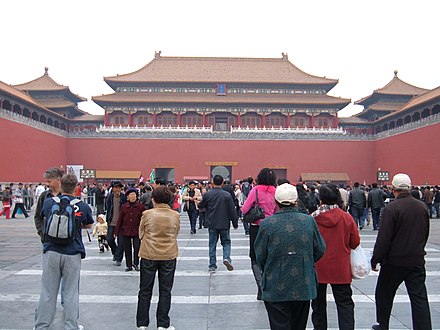
The number of daily visitors is restricted to 80,000 and since tickets are sold online you should go there really early if you want to buy your ticket there. So if possible, buy online on the official website (dead link: January 2023), which is in Chinese only. (See this guide (dead link: January 2023) for how to do so; you cannot pay with international credit cards.)
The usual way to reach Meridian Gate is from Tiananmen Square in Dongcheng: visitors walk 400 m down a ceremonial avenue through the Tiananmen Gate (Gate of Heavenly Peace) and Duanmen Gate (Upright Gate), part of what was once known as the Imperial City. Tour buses and other group vehicles are sometimes allowed to park in the lots along this route; if you are visiting the Forbidden City this way you may not have as far to walk.
An alternative is to go through the parks to the west and east of the ceremonial avenue: Zhongshan Park, which was once the Imperial Shrine of State, and the Beijing Labouring People's Cultural Hall, which used to be the Imperial Shrine of Family. All three routes lead you to Meridian Gate Square.
To get to Tiananmen Square by public transport, take Beijing Subway Line 1 to Tiananmen West or Tiananmen East stations, or Beijing Bus routes 1, 2, 52, 82, 120 to Tiananmen / Tiananmen Square. Travelers arriving this way will have to pass through a security checkpoint before being allowed in; on busy days the lines can stretch almost to the subway station exits.
If you are travelling by taxi, due to security restrictions it is usually not possible to get off at Tiananmen Square, so ask the driver to drop you as close to Tiananmen (天安门) as they can.
You will need to show your passport three times. First at the security gate before the entrance: the queue may look daunting, but throughput is good, and they're not searching for itsy-bitsy liquids like an airport. Second to buy your ticket in the forecourt before the Meridian gate: the kiosks are to the right. If you already bought online, effectively you showed it by entering your ID, go straight to the turnstiles on the left. Once you've paid, your passport is your ticket, so you just show it again at the turnstiles to get in.
Exit is through the north gate (Gate of Divine Might) or the east gate (East Glorious Gate). The north gate is on Jingshan Front Street and across the street from the south entrance of Jingshan Park. Buses 101, 103, 109 and 124 run by this exit gate and stop at Shenwumen (神武门). The north gate is convenient for the nearby Imperial gardens of Jingshan Park and Beihai Park (see Xicheng). The east gate is the most convenient way to return to Tiananmen Square or to reach the Wangfujing shopping and food area (see Dongcheng), and the Jinyu Hutong subway station is only 800 meters from the east gate, serving Line 8 which leads to Shichahai and the Olympic venues, or the Temple of Heaven. Also don't miss the towers and exhibits on top of the wall walkway between the north and east gates.
Get around

The Forbidden City is usually described in two sections. The "Outer Court", in the south, was designed to be where the business of governing the empire was carried out, while the "Inner Palace", in the north, was the home of the Emperor and his family. The buildings are arranged along a central axis, and two subsidiary axes in the east and west.
The usual way to get around the Forbidden City is on foot. There is a designated accessibility route (dead link: February 2023) inside the Forbidden City.
Operating hours
The Forbidden City is open Tuesday through Sunday all year round, and on national holidays that fall on Mondays, and is open every day during the summer vacation period (July and August). Hours as follows:
- April – October: 08:30 to 17:00. Last entry to museum galleries 16:10. Last tickets are sold at 16:00.
- Summer vacation (mid-July to late August) hours: 08:00 to 17:00. Last entry to museum galleries 16:10. Last tickets are sold at 16:00
- November – March: 08:30 to 16:30. Last entry to museum galleries 15:40. Last tickets are sold at 15:30.
Get here at opening time if you want to walk through the vast and spectacular courtyards in relative peace.
Admission
April – October: ¥60; November – March: ¥40
- For entrance to the Treasures Gallery (including the Stone Drum Gallery) and to the Clocks Gallery, additional ¥10 tickets are required.
- Children under 120 cm in height are free of charge.
- Special ¥20 tickets are available for students enrolled in Chinese primary and secondary schools and universities with valid student ID or certified letter from the school administrator. This applies to foreign students and students from Hong Kong, Macau, and Taiwan, but excludes post-graduate and adult education students. However, it's worth an under-18 showing their passport and asking for a student ticket, as it can sometimes work.
Passports are required to purchase tickets for foreigners. Electronic-GPS-enabled audio guides are available after the security gates, prices are ¥20 for Chinese audio guides, ¥40 for foreign language audio guides (over 30 languages available). Many non-native English speakers prefer the English version even over those in their language, since it is narrated by Roger Moore, the English actor famous for playing James Bond during the 1970s and '80s. The explains certain temples along the central axis and their uses. The signs posted around and on buildings inside are fairly short and are written in both Chinese and English; some also include Korean, Japanese and Russian text.
Suggested itineraries
 The usual route for visitors is to follow the central axis, which starts from Meridian Gate and leads through the largest halls and palaces before reaching the Imperial Garden and exit through the Gate of Divine Might. There are various buildings and museum displays to the left and right of this main axis. Even on a full day's visit it would be difficult to see all of these, so it is best to plan ahead of time which you want to see, and take detours from the main axis to see them.
The usual route for visitors is to follow the central axis, which starts from Meridian Gate and leads through the largest halls and palaces before reaching the Imperial Garden and exit through the Gate of Divine Might. There are various buildings and museum displays to the left and right of this main axis. Even on a full day's visit it would be difficult to see all of these, so it is best to plan ahead of time which you want to see, and take detours from the main axis to see them.
Some suggested itineraries if you are on a tight timetable:
- 2-hour itinerary 1: Meridian Gate (A) > Gate of Supreme Harmony (F) > (exhibits on square before Hall of Supreme Harmony) > Three main halls of Outer Court (G) > Three main palaces of Inner Palace (L) > Palace Garden (M) > Gate of Divine Might (B)
- 2-hour itinerary 2: Meridian Gate (A) > Gate of Supreme Harmony (F) > Three main halls of Outer Court (G) > (exhibits around the three halls) > Three main palaces of Inner Palace (L) > Palace Garden (M) > Gate of Divine Might (B)
- Half day itinerary 1: Meridian Gate (A) > Hall of Literary Glory (Porcelain Gallery) (J) > Gate of Supreme Harmony (F) > Three main halls of Outer Court (G) > Hall of Ancestral Offerings (Clocks Gallery) > Three main palaces of Inner Palace (L) > Hall of Mental Cultivation (N) > Western six palaces (western part of Inner Palace) > Palace Garden (M) > Gate of Divine Might (B)
- Half day itinerary 2: Meridian Gate (A) > Hall of Military Eminence (Paintings and Calligraphy Gallery) (H) > Gate of Supreme Harmony (F) > Three main halls of Outer Court (G) > Hall of Ancestral Offerings (Clocks Gallery) > Three main palaces of Inner Palace (L) > Eastern six palaces (eastern part of Inner Palace) > Fasting Palace (south-eastern part of Inner Palace) > Palace of Tranquil Longevity (Treasures Gallery, etc) (O) > Gate of Divine Might (B)
A suggested itinerary if you have a full day:
- Meridian Gate (A) > Hall of Military Eminence (Paintings and Calligraphy Gallery) (H) > Hall of Literary Glory (Porcelain Gallery) (J) > Gate of Supreme Harmony (F) > Three main halls of Outer Court (G) > Hall of Ancestral Offerings (Clocks Gallery) > Three main palaces of Inner Palace (L) > Hall of Mental Cultivation (N) > Western six palaces (western part of Inner Palace) > Palace Garden (M) > Eastern six palaces (eastern part of Inner Palace) > Hall of Ancestral Offerings (Clocks Gallery) > Palace of Tranquil Longevity (Treasures Gallery, etc) (O) > Gate of Divine Might (B)
Only two-fifths of the area of the palace is open but more sections open all the time. Wandering to the right or left can yield some beautiful secluded courtyards and, of course, padlocked dead ends.
See
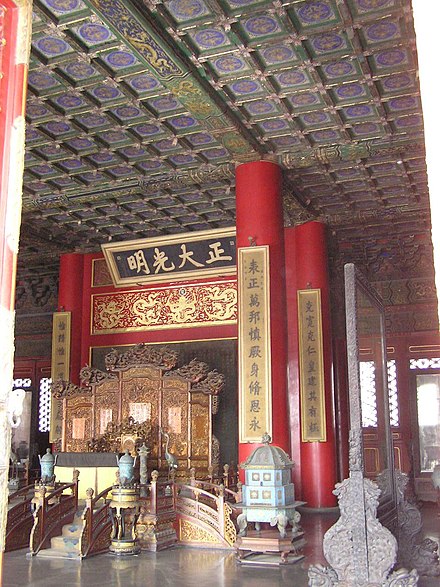
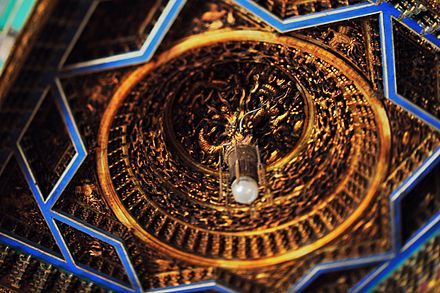
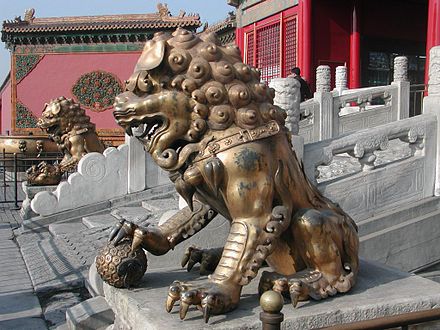
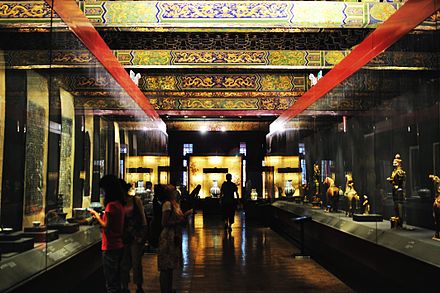

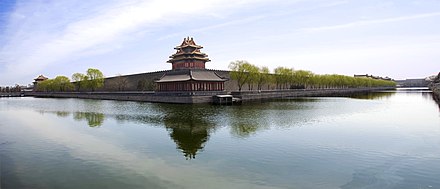
Inside the Forbidden City
- Outer Court (外朝). The imposing set of buildings designed to be the ceremonial centre of the palace. Visitors enter through Meridian Gate (A), the imposing main gate with unique protruding side wings, followed by the Gate of Supreme Harmony (F), where the Emperor sometimes held court. There are then three grand halls set on a multi-tiered marble platform, including the Hall of Supreme Harmony (G), which was the ceremonial throne room used for the grandest of state occasions. To preserve the fine paving stones, it is no longer possible to enter the halls, but you can admire the interiors from the front door.
- Paintings and Calligraphy Gallery - Hall of Military Eminence (武英殿). Somewhat ironically, this set of buildings (H) built to celebrate military valour now houses the Palace Museum's paintings and calligraphy gallery. Works from the Palace Museum's extensive collection are rotated through the gallery and changed every few months. To reach the Hall of Military Eminence, go through the gate on the left after the Meridian Gate but before going through the Gate of Supreme Harmony.
- Porcelain and Ceramics - Hall of Literary Glory (文华殿), 39.915501°, 116.399188°. This mini-palace (J) was variously used as the Crown Prince's court and an imperial Confucian lecture hall. It now houses the Palace Museum's porcelain and ceramics gallery. The gallery's exhibits trace through the development of Chinese porcelain, and includes items from the large imperial collection held by the Palace Museum. To reach the Hall of Literary Glory, go through the gate on the right after the Meridian Gate but before going through the Gate of Supreme Harmony.
- Inner Palace (内廷). Form the Outer Court, the central section of the Inner Palace is accessed through the Gate of Heavenly Purity. The Inner Palace, like the Outer Court, is centred on three main buildings. The grandest, the Palace of Heavenly Purity (L) was designed to house the Emperor's bed chamber, but later became a throne room where the Emperor held court with his ministers. The Palace of Earthly Tranquillity was designed to be the Empress' bed chamber, but later became a Shamanist shrine. The Emperor and Empress' marital suite, where they spent their wedding night, is in this building. To the west of this main complex, the much smaller Hall of Mental Cultivation (N) was in later years the Emperor's actual bedchamber and office. You can even see where the Empress Dowager Cixi ruled China from behind a curtain for 47 years. The remainder of the Inner Palace is made up of a series of small courtyards, the homes of the Emperor's concubines and household. Look out for the "Crystal Palace", a cast iron and glass building of which sadly only the skeleton remains. The Palace Museum's Bronzeware Gallery is also in the Inner Palace. Other permanent and temporary exhibitions are also housed around the Inner Palace.
- Treasures Gallery - Palace of Tranquil Longevity (宁寿宫), 39.9184°, 116.3941°. A palace in itself with its own "Outer Court", "Inner Palace" and "Imperial Garden", this complex (O) was designed for the Qianlong Emperor to enjoy his retirement after abdication - but he was too busy giving his son instructions on government to ever use it. Look for the glaze-tiled Nine Dragon Screen in front of the main entrance. These buildings now house the Palace Museum's Treasures Gallery (珍宝馆), which includes works in precious metals and precious or semi-precious stones. A separate admission charge applies. The Stone Drum Gallery, which houses a set of ancient drum-shaped stone carvings, and the Theatre Gallery, housed in a traditional Chinese-style outdoor theatre, are also in this complex. The mini-Palace Garden, while smaller than the main garden, is more finely decorated with some small but elaborate garden buildings. ¥10
- Clocks Gallery - Hall of Ancestral Offerings (奉先殿). Built as a shrine for making offerings to ancestors, this set of buildings on the eastern side of the Inner Palace now houses the Palace Museum's clocks display, the major portion of which are elaborate European-style mechanical clocks - including a calligraphy-writing automaton! Demonstrations are held at 11:00 and 14:00, where some of the fanciest clocks in the collections are put on show. Separate admission charge applies. ¥10
- Palace Garden (御花园). The Palace's main garden is among the smallest of Beijing's imperial gardens, but the emperors have managed to pack a lot of pavilions, ponds, trees and ornamental rocks into the space. It would be a nice place to relax after your tour of the Forbidden City, if it weren't packed with thousands of tourists with exactly the same idea. The Palace Garden leads in the north to the Gate of Divine Might, the north gate and exit of the Forbidden City.
Outside the Forbidden City
- Wall, moat and corner towers. The Forbidden City's imposing walls and tranquil moat can only be admired from outside the complex. As you leave the Forbidden City, the corner towers (E) are well worth seeing for their elaborate roof structure, modelled on mythical "ideal" pavilions in Chinese art.
- Imperial Ancestral Temple (太庙), 39.91°, 116.393611°. 08:00-22:00. This is one of the grandest temple complexes in Beijing, often forgotten by visitors keen to get to or from the nearby Forbidden City. The temple complex is located to the east of the ceremonial way leading from Tiananmen Square to Meridian Gate. This was where the Emperor performed rites to honour his own ancestors. Sadly, much of the interior, including the ancestral tablets, were destroyed by Red Guards during the Cultural Revolution, and the main building now serves as a museum of musical instruments. The park surrounding the temple is called the Labouring People's Cultural Palace. The main gate is on East Chang'an Avenue, east of Tiananmen Gate, but the park also has side and back gates. The main halls of the temple are in the same style and on a similar scale to the main halls of the Forbidden City but has fewer tourists, so it is a popular destination for photographers, especially wedding photographers. ¥15 (park and temple); ¥2 (park only)
- Altar of Land and Grain (社稷坛). 08:00-22:00. Located west of the ceremonial way leading from Tiananmen Square to Meridian Gate in a mirrored position to the Imperial Ancestral Temple, the Emperor came to this altar to venerate the land of his empire, rather than his family. The park surrounding the temple is called Zhongshan Park. There are fewer grand buildings here, but the gardens and greenhouses are famed for their flowers, which are on show year-round. ¥3 (park); ¥5 (inner gardens); seasonal prices apply during flowering season
- Upright Gate (端门), 39.910396°, 116.397364°. The Upright Gate is located between Tiananmen gate and the Meridian Gate, along the ceremonial way. It is nearly identical to Tiananmen gate, and is also open to the public. 2020-09-12
Do
- Shopping. Souvenir stores and stalls of varying quality dot the Forbidden City. Many of these are overpriced tourist traps, but if you are interested in Chinese art, it can be a good place to find the Palace Museum's high-quality reproductions of paintings and other artworks from its collection.
- Clocks demonstration, Clocks gallery - Hall of Ancestral Offering. 11:00, 14:00. Some of the fanciest mechanical clocks from the Imperial collection are wound up and put into action twice a day - watch them reveal their elaborate surprises. ¥10 entry to gallery
Eat
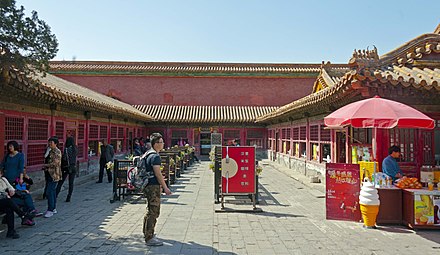 While there are some famous restaurants in the Forbidden City precinct (see listings below), dining options are limited within the Forbidden City. There are some cafes and kiosks, but the range is limited and prices are high. As gas fires are not permitted within the historical buildings, ready meals and noodles are the main hot food options, along with sandwiches. It is probably better and cheaper to bring your own packed lunch. A new restaurant with 500 covers is reportedly being planned for the Inner Palace area, in addition to the existing food court in the northwest near the Hall of Mental Cultivation.
While there are some famous restaurants in the Forbidden City precinct (see listings below), dining options are limited within the Forbidden City. There are some cafes and kiosks, but the range is limited and prices are high. As gas fires are not permitted within the historical buildings, ready meals and noodles are the main hot food options, along with sandwiches. It is probably better and cheaper to bring your own packed lunch. A new restaurant with 500 covers is reportedly being planned for the Inner Palace area, in addition to the existing food court in the northwest near the Hall of Mental Cultivation.
Restaurants nearby include:
- Lai Jin Yu Xuan (来今雨轩), 39.910689°, 116.396350°. This 100-year-old restaurant is located within Zhongshan Park, just outside the Forbidden City's walls to the south west. It was a favourite haunt of Beijing's literati in the 20th century, and is today famed for its "Red Mansion" banquet, with dishes taken from the classical Chinese novel Dreams of the Red Chamber. The Lai Jin Yu Xuan tea house is also in the same park, and is a good place to enjoy a cup of tea amidst quiet greenery in the centre of Beijing.
- Cheng Fu Yan (程府宴), 38 Nanchangjie (outside west gate of Zhongshan Park), 39.912715°, 116.391712°. One of Beijing's famed "imperial cuisine" restaurants that also has a private dining room decorated as a replica of Chairman Mao's study, Cheng Fu Yan's odd combination of the imperial and revolutionary reflects its location - just outside the Forbidden City's south wall and faces the leadership compound of Zhongnanhai across the street. The owner's grandfather spent 22 years cooking for Chairman Mao and Madame Mao. The intricate flavour of the elaborate dishes are matched only by the jaw-dropping prices for the de luxe set menus, but a la carte is also available. ¥1080-2080 per head set menus
Drink
- Forbidden City Cafe. After the controversial Forbidden City branch of Starbucks closed in 2007, the former Duty Room of the Nine Ministers has hosted a very similar café run by the Palace Museum. The prices are high but comparable to Starbucks prices in China, and the selection of drinks and snacks is also similar. ¥20-30 coffee
- Lai Jin Yu Xuan Teahouse, Inside Zhongshan Park. Associated with Lai Jin Yu Xuan Restaurant (see "Eat" listing above), this is a peaceful tea house within Zhongshan Park set amongst mature cypress trees, in the south west of the Forbidden City precinct outside the Forbidden City walls.
Sleep
There is no accommodation for visitors inside the Forbidden City, but there are numerous options in the surrounding Dongcheng and Xicheng Districts.
Connect
- Post Box, Gate of Supreme Harmony. The former Palace Museum Post Office closed in 2006, but since 2013 there has been a post box at the Gate of Supreme Harmony. Postcards and letters posted here will be postmarked "Palace Museum". Postcards can be purchased from souvenir shops within the Forbidden City.
Go next
If, like many visitors, your odyssey through the Forbidden City takes you from south to north and you leave via the latter gate, you may want to visit one of nearby parks and relax before you head back to where you're spending the night. Admission to Jingshan Park, just across Jingshan Front Street, costs ¥2 and gets you to the top of 45-meter (150-foot) Prospect Hill, the highest point in the ancient city of Beijing, built from the earth removed to create the moats. If you don't mind the climb, retracing the steps of the Chongzhen emperor, who hanged himself at the hilltop to end the Ming Dynasty in 1644, you'll get a lovely view over the palace you just spent the last few hours walking through, and (given clear enough weather and minimal smog) Tiananmen Square beyond and much of the rest of central Beijing. The park will be crowded on major tourist days due to its proximity to the North Gate, however.
Up for some more walking after you've refreshed yourself with a drink from one of the trucks outside the North Gate, and you'd rather not climb? Turn left and follow the moat or the street to the main entrance of Beihai Park, 500 m (800 ft) to the west. This much larger park (admission: ¥20) features a large beautiful lake with boats you can rent, restaurants, and the White Pagoda on Qiónghuá Island at the center, which offers a similar view to Jingshan's. It's a little less touristy, and on a nice weekend afternoon you'll find plenty of locals here taking it all in, giving it a similar vibe to Central Park in New York or Hyde Park in London.
The Mukden Palace in Shenyang is a lot farther away, but if your journey through China takes you into Manchuria you might want to make arrangements to visit it as well. It was added to the Forbidden City's inscription as a World Heritage Site in 2005, as the other major surviving imperial palace in China. Built by the Qing emperors, who hailed from that region, it was modeled on its Beijing original, but features touches of Manchurian and Tibetan architecture as well.
If you have enough time on your hands, consider heading to Taipei to visit the National Palace Museum, where many of the Emperor's treasures originally housed in the Forbidden City are on display. Flights from Beijing to Taipei take around 3 hours.